Business and Business Environment Report
VerifiedAdded on 2020/12/09
|14
|5430
|137
Report
AI Summary
This report analyzes Tesco, a leading grocery retailer, examining its organizational structure, vision, mission, and objectives. It includes SWOT and PESTLE analyses, highlighting internal strengths and weaknesses, as well as external opportunities and threats. The report also explores the impact of the macro environment on Tesco's business operations.
Contribute Materials
Your contribution can guide someone’s learning journey. Share your
documents today.
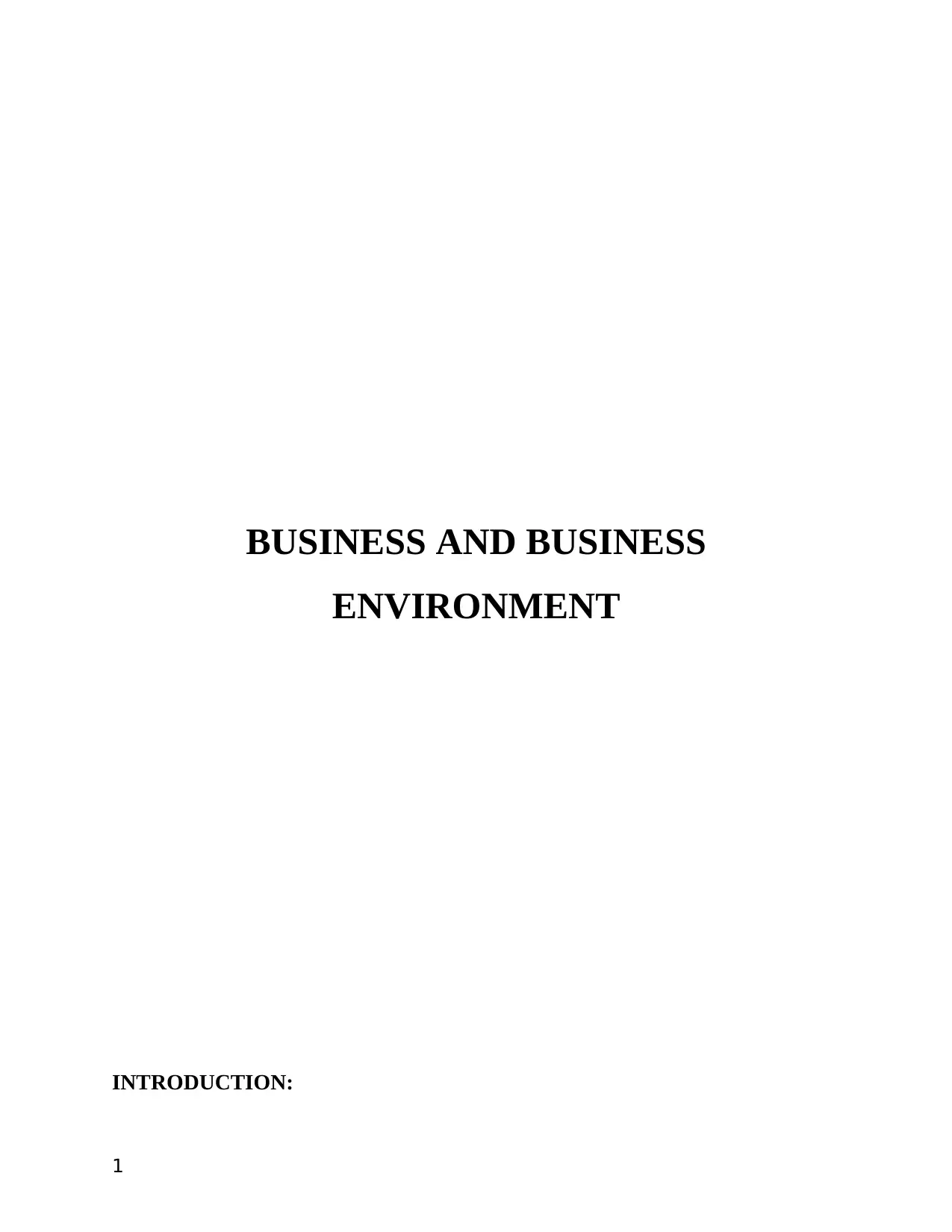
BUSINESS AND BUSINESS
ENVIRONMENT
INTRODUCTION:
1
ENVIRONMENT
INTRODUCTION:
1
Secure Best Marks with AI Grader
Need help grading? Try our AI Grader for instant feedback on your assignments.
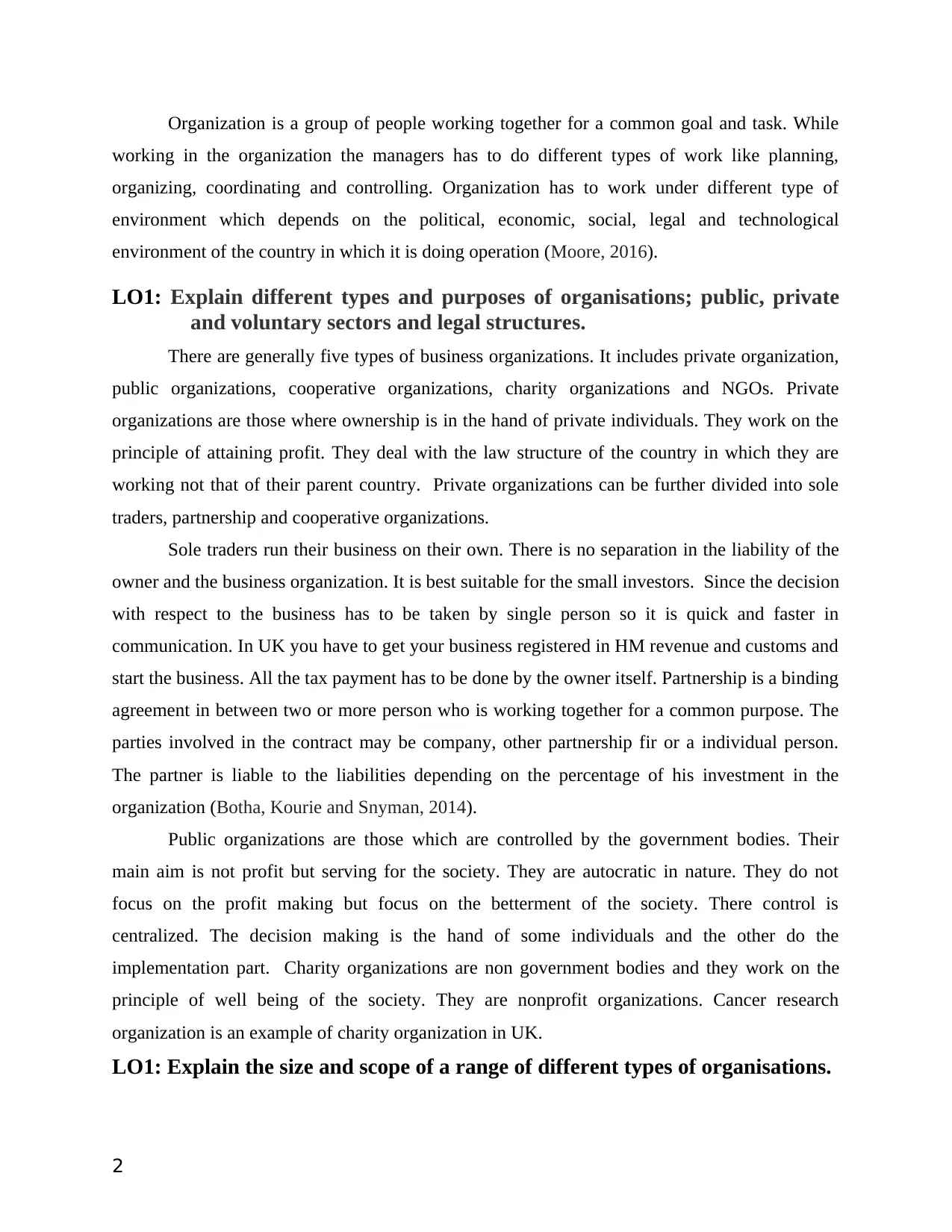
Organization is a group of people working together for a common goal and task. While
working in the organization the managers has to do different types of work like planning,
organizing, coordinating and controlling. Organization has to work under different type of
environment which depends on the political, economic, social, legal and technological
environment of the country in which it is doing operation (Moore, 2016).
LO1: Explain different types and purposes of organisations; public, private
and voluntary sectors and legal structures.
There are generally five types of business organizations. It includes private organization,
public organizations, cooperative organizations, charity organizations and NGOs. Private
organizations are those where ownership is in the hand of private individuals. They work on the
principle of attaining profit. They deal with the law structure of the country in which they are
working not that of their parent country. Private organizations can be further divided into sole
traders, partnership and cooperative organizations.
Sole traders run their business on their own. There is no separation in the liability of the
owner and the business organization. It is best suitable for the small investors. Since the decision
with respect to the business has to be taken by single person so it is quick and faster in
communication. In UK you have to get your business registered in HM revenue and customs and
start the business. All the tax payment has to be done by the owner itself. Partnership is a binding
agreement in between two or more person who is working together for a common purpose. The
parties involved in the contract may be company, other partnership fir or a individual person.
The partner is liable to the liabilities depending on the percentage of his investment in the
organization (Botha, Kourie and Snyman, 2014).
Public organizations are those which are controlled by the government bodies. Their
main aim is not profit but serving for the society. They are autocratic in nature. They do not
focus on the profit making but focus on the betterment of the society. There control is
centralized. The decision making is the hand of some individuals and the other do the
implementation part. Charity organizations are non government bodies and they work on the
principle of well being of the society. They are nonprofit organizations. Cancer research
organization is an example of charity organization in UK.
LO1: Explain the size and scope of a range of different types of organisations.
2
working in the organization the managers has to do different types of work like planning,
organizing, coordinating and controlling. Organization has to work under different type of
environment which depends on the political, economic, social, legal and technological
environment of the country in which it is doing operation (Moore, 2016).
LO1: Explain different types and purposes of organisations; public, private
and voluntary sectors and legal structures.
There are generally five types of business organizations. It includes private organization,
public organizations, cooperative organizations, charity organizations and NGOs. Private
organizations are those where ownership is in the hand of private individuals. They work on the
principle of attaining profit. They deal with the law structure of the country in which they are
working not that of their parent country. Private organizations can be further divided into sole
traders, partnership and cooperative organizations.
Sole traders run their business on their own. There is no separation in the liability of the
owner and the business organization. It is best suitable for the small investors. Since the decision
with respect to the business has to be taken by single person so it is quick and faster in
communication. In UK you have to get your business registered in HM revenue and customs and
start the business. All the tax payment has to be done by the owner itself. Partnership is a binding
agreement in between two or more person who is working together for a common purpose. The
parties involved in the contract may be company, other partnership fir or a individual person.
The partner is liable to the liabilities depending on the percentage of his investment in the
organization (Botha, Kourie and Snyman, 2014).
Public organizations are those which are controlled by the government bodies. Their
main aim is not profit but serving for the society. They are autocratic in nature. They do not
focus on the profit making but focus on the betterment of the society. There control is
centralized. The decision making is the hand of some individuals and the other do the
implementation part. Charity organizations are non government bodies and they work on the
principle of well being of the society. They are nonprofit organizations. Cancer research
organization is an example of charity organization in UK.
LO1: Explain the size and scope of a range of different types of organisations.
2
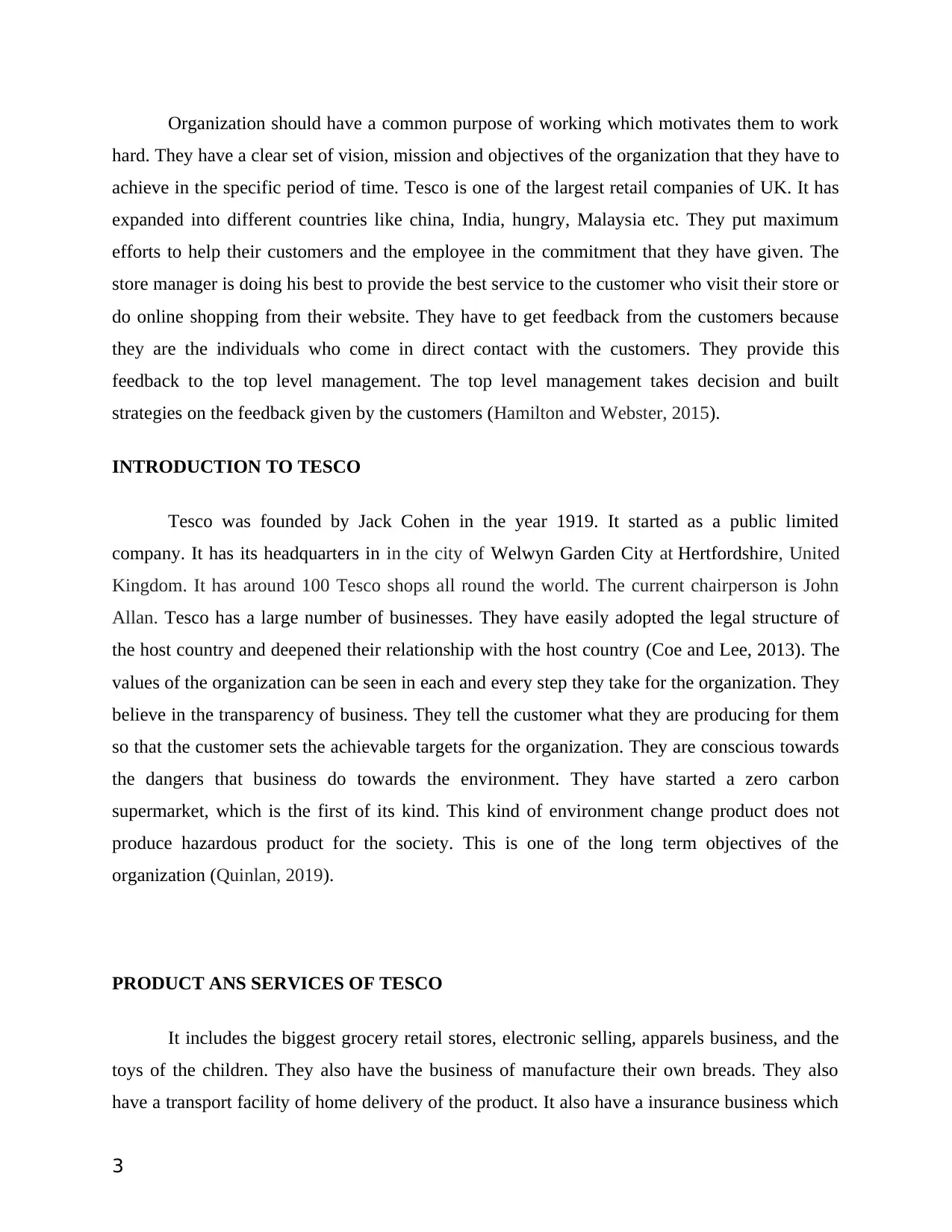
Organization should have a common purpose of working which motivates them to work
hard. They have a clear set of vision, mission and objectives of the organization that they have to
achieve in the specific period of time. Tesco is one of the largest retail companies of UK. It has
expanded into different countries like china, India, hungry, Malaysia etc. They put maximum
efforts to help their customers and the employee in the commitment that they have given. The
store manager is doing his best to provide the best service to the customer who visit their store or
do online shopping from their website. They have to get feedback from the customers because
they are the individuals who come in direct contact with the customers. They provide this
feedback to the top level management. The top level management takes decision and built
strategies on the feedback given by the customers (Hamilton and Webster, 2015).
INTRODUCTION TO TESCO
Tesco was founded by Jack Cohen in the year 1919. It started as a public limited
company. It has its headquarters in in the city of Welwyn Garden City at Hertfordshire, United
Kingdom. It has around 100 Tesco shops all round the world. The current chairperson is John
Allan. Tesco has a large number of businesses. They have easily adopted the legal structure of
the host country and deepened their relationship with the host country (Coe and Lee, 2013). The
values of the organization can be seen in each and every step they take for the organization. They
believe in the transparency of business. They tell the customer what they are producing for them
so that the customer sets the achievable targets for the organization. They are conscious towards
the dangers that business do towards the environment. They have started a zero carbon
supermarket, which is the first of its kind. This kind of environment change product does not
produce hazardous product for the society. This is one of the long term objectives of the
organization (Quinlan, 2019).
PRODUCT ANS SERVICES OF TESCO
It includes the biggest grocery retail stores, electronic selling, apparels business, and the
toys of the children. They also have the business of manufacture their own breads. They also
have a transport facility of home delivery of the product. It also have a insurance business which
3
hard. They have a clear set of vision, mission and objectives of the organization that they have to
achieve in the specific period of time. Tesco is one of the largest retail companies of UK. It has
expanded into different countries like china, India, hungry, Malaysia etc. They put maximum
efforts to help their customers and the employee in the commitment that they have given. The
store manager is doing his best to provide the best service to the customer who visit their store or
do online shopping from their website. They have to get feedback from the customers because
they are the individuals who come in direct contact with the customers. They provide this
feedback to the top level management. The top level management takes decision and built
strategies on the feedback given by the customers (Hamilton and Webster, 2015).
INTRODUCTION TO TESCO
Tesco was founded by Jack Cohen in the year 1919. It started as a public limited
company. It has its headquarters in in the city of Welwyn Garden City at Hertfordshire, United
Kingdom. It has around 100 Tesco shops all round the world. The current chairperson is John
Allan. Tesco has a large number of businesses. They have easily adopted the legal structure of
the host country and deepened their relationship with the host country (Coe and Lee, 2013). The
values of the organization can be seen in each and every step they take for the organization. They
believe in the transparency of business. They tell the customer what they are producing for them
so that the customer sets the achievable targets for the organization. They are conscious towards
the dangers that business do towards the environment. They have started a zero carbon
supermarket, which is the first of its kind. This kind of environment change product does not
produce hazardous product for the society. This is one of the long term objectives of the
organization (Quinlan, 2019).
PRODUCT ANS SERVICES OF TESCO
It includes the biggest grocery retail stores, electronic selling, apparels business, and the
toys of the children. They also have the business of manufacture their own breads. They also
have a transport facility of home delivery of the product. It also have a insurance business which
3
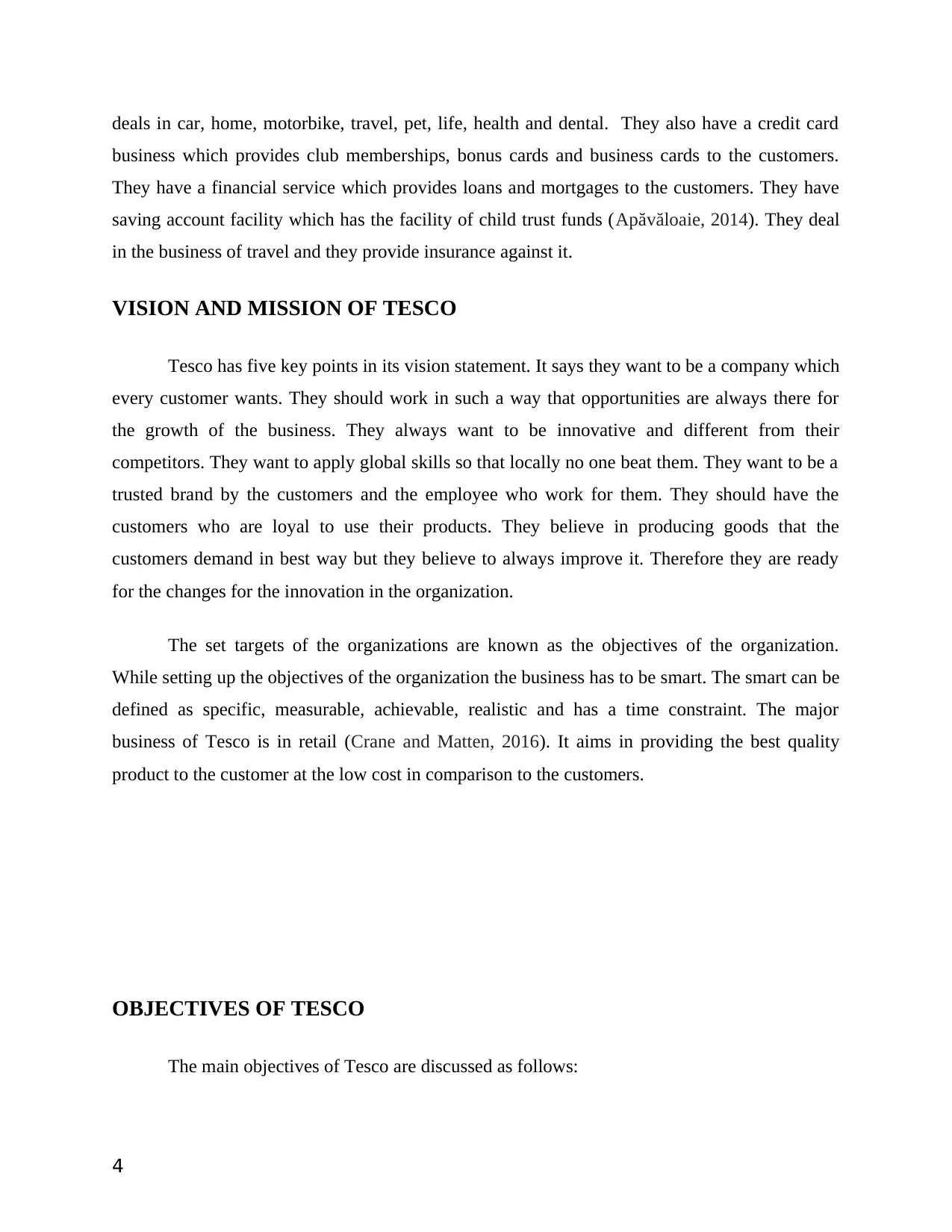
deals in car, home, motorbike, travel, pet, life, health and dental. They also have a credit card
business which provides club memberships, bonus cards and business cards to the customers.
They have a financial service which provides loans and mortgages to the customers. They have
saving account facility which has the facility of child trust funds (Apăvăloaie, 2014). They deal
in the business of travel and they provide insurance against it.
VISION AND MISSION OF TESCO
Tesco has five key points in its vision statement. It says they want to be a company which
every customer wants. They should work in such a way that opportunities are always there for
the growth of the business. They always want to be innovative and different from their
competitors. They want to apply global skills so that locally no one beat them. They want to be a
trusted brand by the customers and the employee who work for them. They should have the
customers who are loyal to use their products. They believe in producing goods that the
customers demand in best way but they believe to always improve it. Therefore they are ready
for the changes for the innovation in the organization.
The set targets of the organizations are known as the objectives of the organization.
While setting up the objectives of the organization the business has to be smart. The smart can be
defined as specific, measurable, achievable, realistic and has a time constraint. The major
business of Tesco is in retail (Crane and Matten, 2016). It aims in providing the best quality
product to the customer at the low cost in comparison to the customers.
OBJECTIVES OF TESCO
The main objectives of Tesco are discussed as follows:
4
business which provides club memberships, bonus cards and business cards to the customers.
They have a financial service which provides loans and mortgages to the customers. They have
saving account facility which has the facility of child trust funds (Apăvăloaie, 2014). They deal
in the business of travel and they provide insurance against it.
VISION AND MISSION OF TESCO
Tesco has five key points in its vision statement. It says they want to be a company which
every customer wants. They should work in such a way that opportunities are always there for
the growth of the business. They always want to be innovative and different from their
competitors. They want to apply global skills so that locally no one beat them. They want to be a
trusted brand by the customers and the employee who work for them. They should have the
customers who are loyal to use their products. They believe in producing goods that the
customers demand in best way but they believe to always improve it. Therefore they are ready
for the changes for the innovation in the organization.
The set targets of the organizations are known as the objectives of the organization.
While setting up the objectives of the organization the business has to be smart. The smart can be
defined as specific, measurable, achievable, realistic and has a time constraint. The major
business of Tesco is in retail (Crane and Matten, 2016). It aims in providing the best quality
product to the customer at the low cost in comparison to the customers.
OBJECTIVES OF TESCO
The main objectives of Tesco are discussed as follows:
4
Secure Best Marks with AI Grader
Need help grading? Try our AI Grader for instant feedback on your assignments.
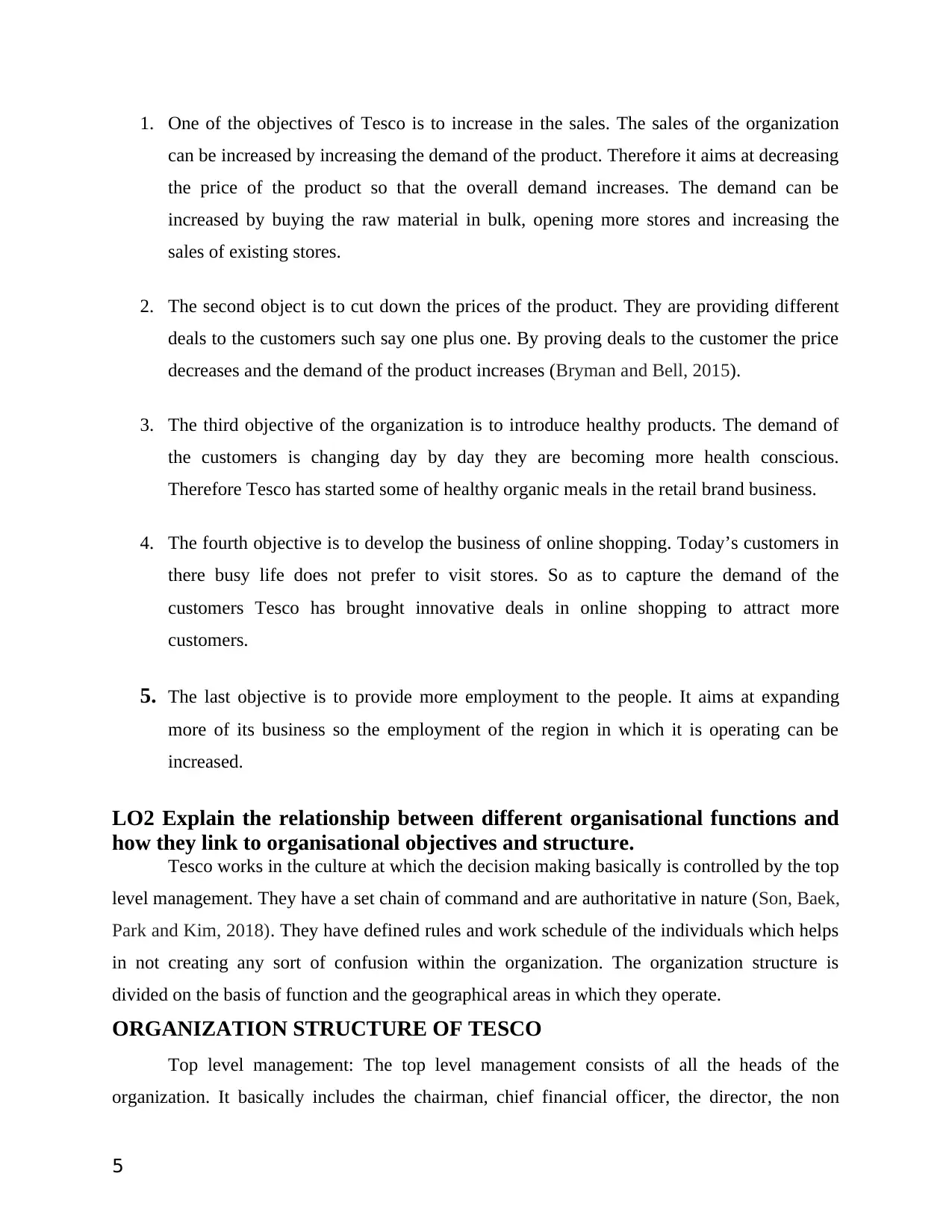
1. One of the objectives of Tesco is to increase in the sales. The sales of the organization
can be increased by increasing the demand of the product. Therefore it aims at decreasing
the price of the product so that the overall demand increases. The demand can be
increased by buying the raw material in bulk, opening more stores and increasing the
sales of existing stores.
2. The second object is to cut down the prices of the product. They are providing different
deals to the customers such say one plus one. By proving deals to the customer the price
decreases and the demand of the product increases (Bryman and Bell, 2015).
3. The third objective of the organization is to introduce healthy products. The demand of
the customers is changing day by day they are becoming more health conscious.
Therefore Tesco has started some of healthy organic meals in the retail brand business.
4. The fourth objective is to develop the business of online shopping. Today’s customers in
there busy life does not prefer to visit stores. So as to capture the demand of the
customers Tesco has brought innovative deals in online shopping to attract more
customers.
5. The last objective is to provide more employment to the people. It aims at expanding
more of its business so the employment of the region in which it is operating can be
increased.
LO2 Explain the relationship between different organisational functions and
how they link to organisational objectives and structure.
Tesco works in the culture at which the decision making basically is controlled by the top
level management. They have a set chain of command and are authoritative in nature (Son, Baek,
Park and Kim, 2018). They have defined rules and work schedule of the individuals which helps
in not creating any sort of confusion within the organization. The organization structure is
divided on the basis of function and the geographical areas in which they operate.
ORGANIZATION STRUCTURE OF TESCO
Top level management: The top level management consists of all the heads of the
organization. It basically includes the chairman, chief financial officer, the director, the non
5
can be increased by increasing the demand of the product. Therefore it aims at decreasing
the price of the product so that the overall demand increases. The demand can be
increased by buying the raw material in bulk, opening more stores and increasing the
sales of existing stores.
2. The second object is to cut down the prices of the product. They are providing different
deals to the customers such say one plus one. By proving deals to the customer the price
decreases and the demand of the product increases (Bryman and Bell, 2015).
3. The third objective of the organization is to introduce healthy products. The demand of
the customers is changing day by day they are becoming more health conscious.
Therefore Tesco has started some of healthy organic meals in the retail brand business.
4. The fourth objective is to develop the business of online shopping. Today’s customers in
there busy life does not prefer to visit stores. So as to capture the demand of the
customers Tesco has brought innovative deals in online shopping to attract more
customers.
5. The last objective is to provide more employment to the people. It aims at expanding
more of its business so the employment of the region in which it is operating can be
increased.
LO2 Explain the relationship between different organisational functions and
how they link to organisational objectives and structure.
Tesco works in the culture at which the decision making basically is controlled by the top
level management. They have a set chain of command and are authoritative in nature (Son, Baek,
Park and Kim, 2018). They have defined rules and work schedule of the individuals which helps
in not creating any sort of confusion within the organization. The organization structure is
divided on the basis of function and the geographical areas in which they operate.
ORGANIZATION STRUCTURE OF TESCO
Top level management: The top level management consists of all the heads of the
organization. It basically includes the chairman, chief financial officer, the director, the non
5
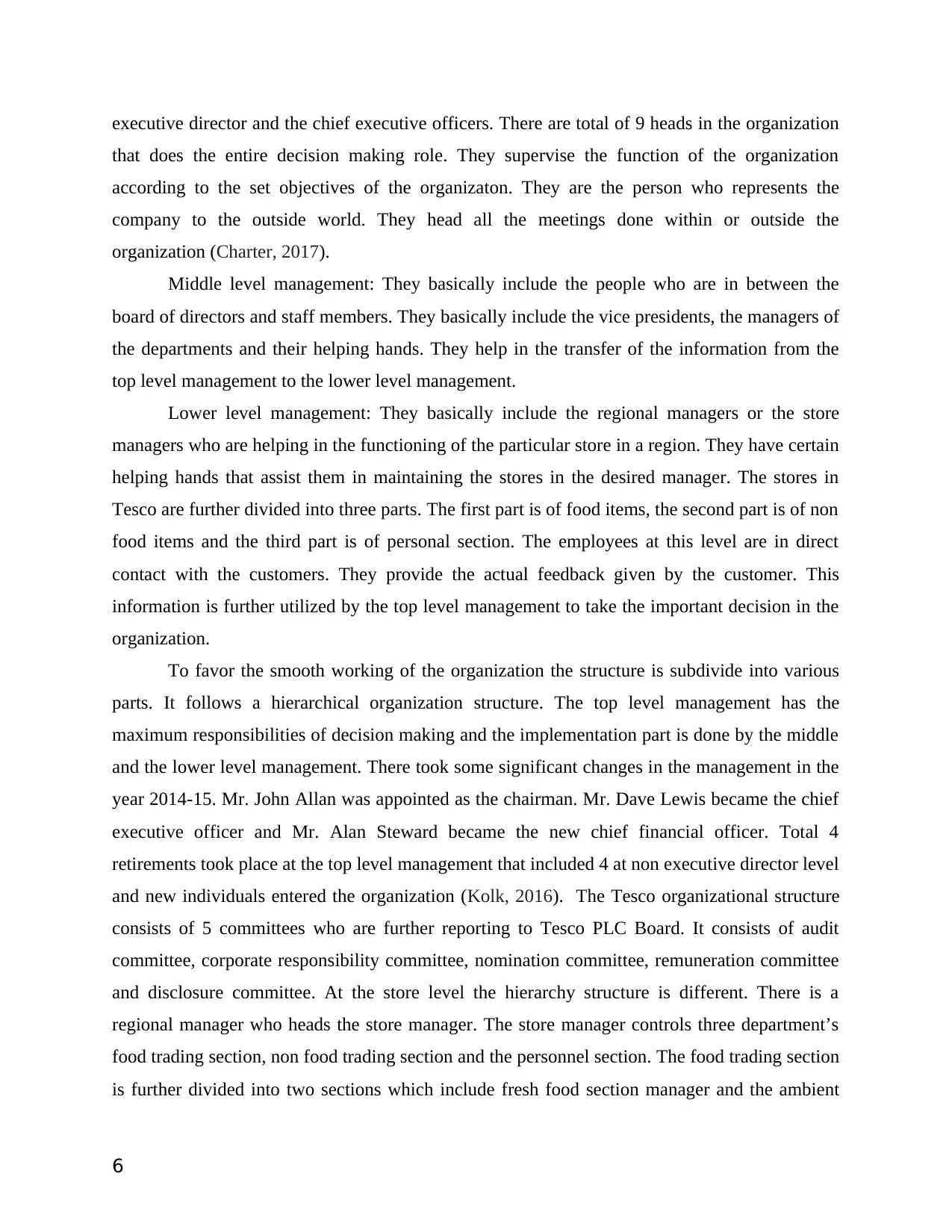
executive director and the chief executive officers. There are total of 9 heads in the organization
that does the entire decision making role. They supervise the function of the organization
according to the set objectives of the organizaton. They are the person who represents the
company to the outside world. They head all the meetings done within or outside the
organization (Charter, 2017).
Middle level management: They basically include the people who are in between the
board of directors and staff members. They basically include the vice presidents, the managers of
the departments and their helping hands. They help in the transfer of the information from the
top level management to the lower level management.
Lower level management: They basically include the regional managers or the store
managers who are helping in the functioning of the particular store in a region. They have certain
helping hands that assist them in maintaining the stores in the desired manager. The stores in
Tesco are further divided into three parts. The first part is of food items, the second part is of non
food items and the third part is of personal section. The employees at this level are in direct
contact with the customers. They provide the actual feedback given by the customer. This
information is further utilized by the top level management to take the important decision in the
organization.
To favor the smooth working of the organization the structure is subdivide into various
parts. It follows a hierarchical organization structure. The top level management has the
maximum responsibilities of decision making and the implementation part is done by the middle
and the lower level management. There took some significant changes in the management in the
year 2014-15. Mr. John Allan was appointed as the chairman. Mr. Dave Lewis became the chief
executive officer and Mr. Alan Steward became the new chief financial officer. Total 4
retirements took place at the top level management that included 4 at non executive director level
and new individuals entered the organization (Kolk, 2016). The Tesco organizational structure
consists of 5 committees who are further reporting to Tesco PLC Board. It consists of audit
committee, corporate responsibility committee, nomination committee, remuneration committee
and disclosure committee. At the store level the hierarchy structure is different. There is a
regional manager who heads the store manager. The store manager controls three department’s
food trading section, non food trading section and the personnel section. The food trading section
is further divided into two sections which include fresh food section manager and the ambient
6
that does the entire decision making role. They supervise the function of the organization
according to the set objectives of the organizaton. They are the person who represents the
company to the outside world. They head all the meetings done within or outside the
organization (Charter, 2017).
Middle level management: They basically include the people who are in between the
board of directors and staff members. They basically include the vice presidents, the managers of
the departments and their helping hands. They help in the transfer of the information from the
top level management to the lower level management.
Lower level management: They basically include the regional managers or the store
managers who are helping in the functioning of the particular store in a region. They have certain
helping hands that assist them in maintaining the stores in the desired manager. The stores in
Tesco are further divided into three parts. The first part is of food items, the second part is of non
food items and the third part is of personal section. The employees at this level are in direct
contact with the customers. They provide the actual feedback given by the customer. This
information is further utilized by the top level management to take the important decision in the
organization.
To favor the smooth working of the organization the structure is subdivide into various
parts. It follows a hierarchical organization structure. The top level management has the
maximum responsibilities of decision making and the implementation part is done by the middle
and the lower level management. There took some significant changes in the management in the
year 2014-15. Mr. John Allan was appointed as the chairman. Mr. Dave Lewis became the chief
executive officer and Mr. Alan Steward became the new chief financial officer. Total 4
retirements took place at the top level management that included 4 at non executive director level
and new individuals entered the organization (Kolk, 2016). The Tesco organizational structure
consists of 5 committees who are further reporting to Tesco PLC Board. It consists of audit
committee, corporate responsibility committee, nomination committee, remuneration committee
and disclosure committee. At the store level the hierarchy structure is different. There is a
regional manager who heads the store manager. The store manager controls three department’s
food trading section, non food trading section and the personnel section. The food trading section
is further divided into two sections which include fresh food section manager and the ambient
6
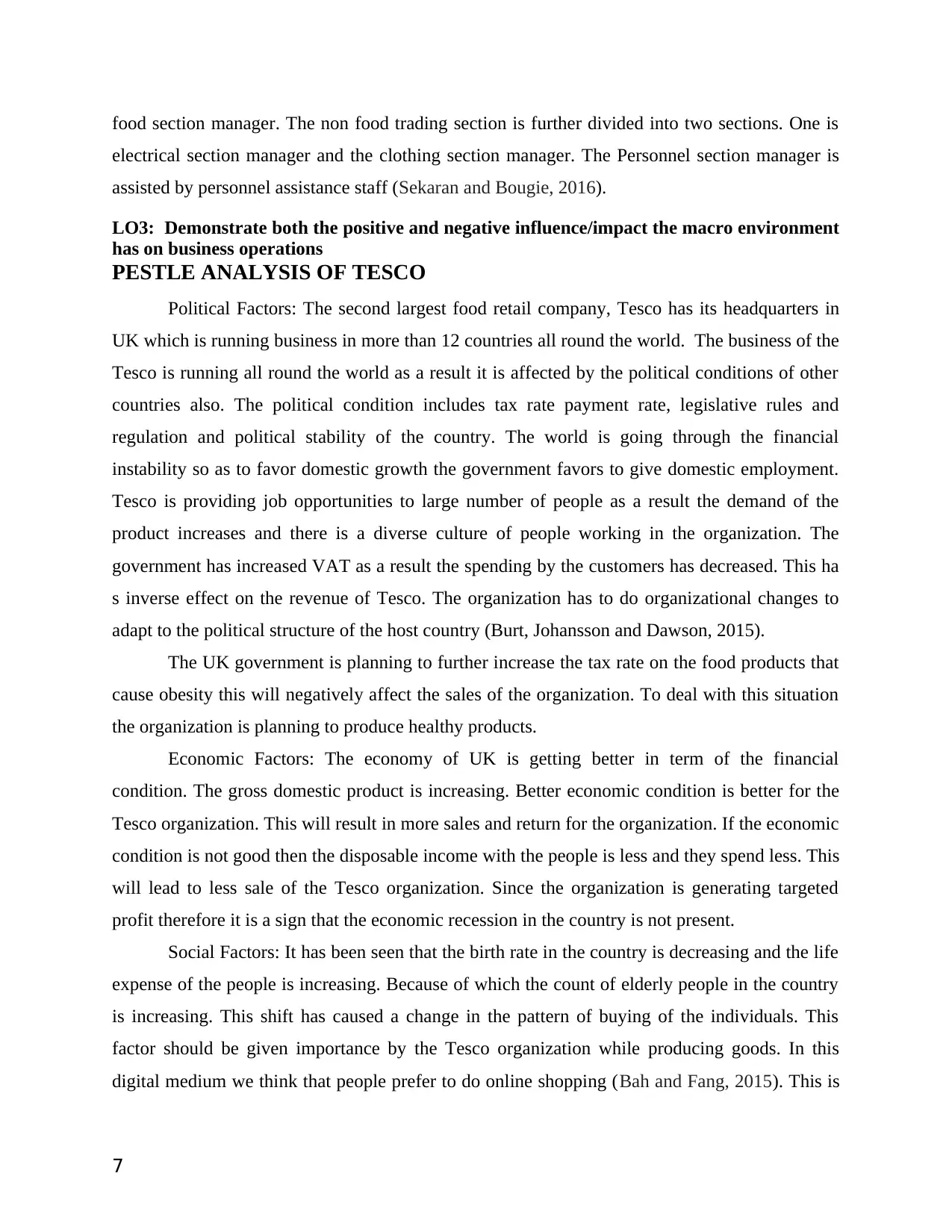
food section manager. The non food trading section is further divided into two sections. One is
electrical section manager and the clothing section manager. The Personnel section manager is
assisted by personnel assistance staff (Sekaran and Bougie, 2016).
LO3: Demonstrate both the positive and negative influence/impact the macro environment
has on business operations
PESTLE ANALYSIS OF TESCO
Political Factors: The second largest food retail company, Tesco has its headquarters in
UK which is running business in more than 12 countries all round the world. The business of the
Tesco is running all round the world as a result it is affected by the political conditions of other
countries also. The political condition includes tax rate payment rate, legislative rules and
regulation and political stability of the country. The world is going through the financial
instability so as to favor domestic growth the government favors to give domestic employment.
Tesco is providing job opportunities to large number of people as a result the demand of the
product increases and there is a diverse culture of people working in the organization. The
government has increased VAT as a result the spending by the customers has decreased. This ha
s inverse effect on the revenue of Tesco. The organization has to do organizational changes to
adapt to the political structure of the host country (Burt, Johansson and Dawson, 2015).
The UK government is planning to further increase the tax rate on the food products that
cause obesity this will negatively affect the sales of the organization. To deal with this situation
the organization is planning to produce healthy products.
Economic Factors: The economy of UK is getting better in term of the financial
condition. The gross domestic product is increasing. Better economic condition is better for the
Tesco organization. This will result in more sales and return for the organization. If the economic
condition is not good then the disposable income with the people is less and they spend less. This
will lead to less sale of the Tesco organization. Since the organization is generating targeted
profit therefore it is a sign that the economic recession in the country is not present.
Social Factors: It has been seen that the birth rate in the country is decreasing and the life
expense of the people is increasing. Because of which the count of elderly people in the country
is increasing. This shift has caused a change in the pattern of buying of the individuals. This
factor should be given importance by the Tesco organization while producing goods. In this
digital medium we think that people prefer to do online shopping (Bah and Fang, 2015). This is
7
electrical section manager and the clothing section manager. The Personnel section manager is
assisted by personnel assistance staff (Sekaran and Bougie, 2016).
LO3: Demonstrate both the positive and negative influence/impact the macro environment
has on business operations
PESTLE ANALYSIS OF TESCO
Political Factors: The second largest food retail company, Tesco has its headquarters in
UK which is running business in more than 12 countries all round the world. The business of the
Tesco is running all round the world as a result it is affected by the political conditions of other
countries also. The political condition includes tax rate payment rate, legislative rules and
regulation and political stability of the country. The world is going through the financial
instability so as to favor domestic growth the government favors to give domestic employment.
Tesco is providing job opportunities to large number of people as a result the demand of the
product increases and there is a diverse culture of people working in the organization. The
government has increased VAT as a result the spending by the customers has decreased. This ha
s inverse effect on the revenue of Tesco. The organization has to do organizational changes to
adapt to the political structure of the host country (Burt, Johansson and Dawson, 2015).
The UK government is planning to further increase the tax rate on the food products that
cause obesity this will negatively affect the sales of the organization. To deal with this situation
the organization is planning to produce healthy products.
Economic Factors: The economy of UK is getting better in term of the financial
condition. The gross domestic product is increasing. Better economic condition is better for the
Tesco organization. This will result in more sales and return for the organization. If the economic
condition is not good then the disposable income with the people is less and they spend less. This
will lead to less sale of the Tesco organization. Since the organization is generating targeted
profit therefore it is a sign that the economic recession in the country is not present.
Social Factors: It has been seen that the birth rate in the country is decreasing and the life
expense of the people is increasing. Because of which the count of elderly people in the country
is increasing. This shift has caused a change in the pattern of buying of the individuals. This
factor should be given importance by the Tesco organization while producing goods. In this
digital medium we think that people prefer to do online shopping (Bah and Fang, 2015). This is
7
Paraphrase This Document
Need a fresh take? Get an instant paraphrase of this document with our AI Paraphraser
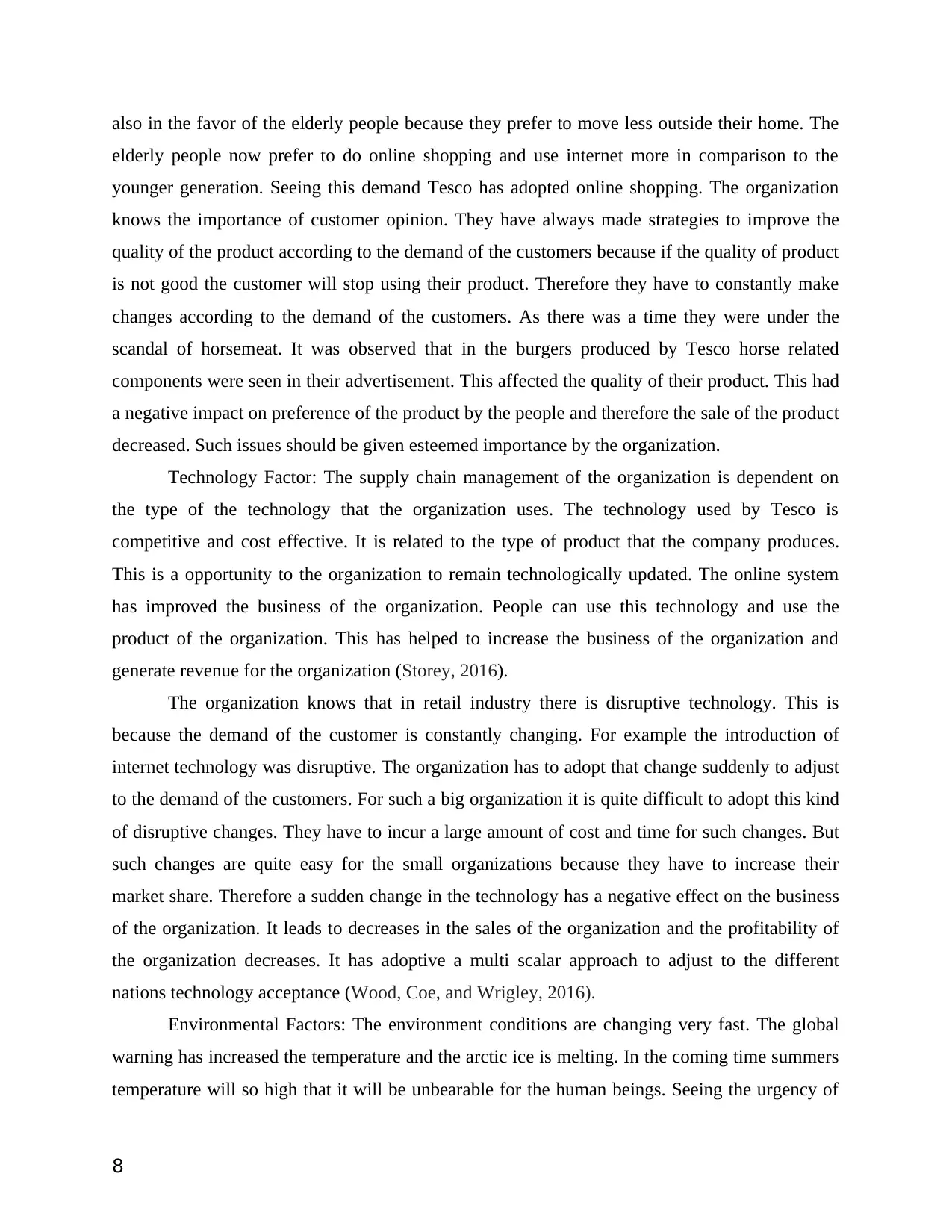
also in the favor of the elderly people because they prefer to move less outside their home. The
elderly people now prefer to do online shopping and use internet more in comparison to the
younger generation. Seeing this demand Tesco has adopted online shopping. The organization
knows the importance of customer opinion. They have always made strategies to improve the
quality of the product according to the demand of the customers because if the quality of product
is not good the customer will stop using their product. Therefore they have to constantly make
changes according to the demand of the customers. As there was a time they were under the
scandal of horsemeat. It was observed that in the burgers produced by Tesco horse related
components were seen in their advertisement. This affected the quality of their product. This had
a negative impact on preference of the product by the people and therefore the sale of the product
decreased. Such issues should be given esteemed importance by the organization.
Technology Factor: The supply chain management of the organization is dependent on
the type of the technology that the organization uses. The technology used by Tesco is
competitive and cost effective. It is related to the type of product that the company produces.
This is a opportunity to the organization to remain technologically updated. The online system
has improved the business of the organization. People can use this technology and use the
product of the organization. This has helped to increase the business of the organization and
generate revenue for the organization (Storey, 2016).
The organization knows that in retail industry there is disruptive technology. This is
because the demand of the customer is constantly changing. For example the introduction of
internet technology was disruptive. The organization has to adopt that change suddenly to adjust
to the demand of the customers. For such a big organization it is quite difficult to adopt this kind
of disruptive changes. They have to incur a large amount of cost and time for such changes. But
such changes are quite easy for the small organizations because they have to increase their
market share. Therefore a sudden change in the technology has a negative effect on the business
of the organization. It leads to decreases in the sales of the organization and the profitability of
the organization decreases. It has adoptive a multi scalar approach to adjust to the different
nations technology acceptance (Wood, Coe, and Wrigley, 2016).
Environmental Factors: The environment conditions are changing very fast. The global
warning has increased the temperature and the arctic ice is melting. In the coming time summers
temperature will so high that it will be unbearable for the human beings. Seeing the urgency of
8
elderly people now prefer to do online shopping and use internet more in comparison to the
younger generation. Seeing this demand Tesco has adopted online shopping. The organization
knows the importance of customer opinion. They have always made strategies to improve the
quality of the product according to the demand of the customers because if the quality of product
is not good the customer will stop using their product. Therefore they have to constantly make
changes according to the demand of the customers. As there was a time they were under the
scandal of horsemeat. It was observed that in the burgers produced by Tesco horse related
components were seen in their advertisement. This affected the quality of their product. This had
a negative impact on preference of the product by the people and therefore the sale of the product
decreased. Such issues should be given esteemed importance by the organization.
Technology Factor: The supply chain management of the organization is dependent on
the type of the technology that the organization uses. The technology used by Tesco is
competitive and cost effective. It is related to the type of product that the company produces.
This is a opportunity to the organization to remain technologically updated. The online system
has improved the business of the organization. People can use this technology and use the
product of the organization. This has helped to increase the business of the organization and
generate revenue for the organization (Storey, 2016).
The organization knows that in retail industry there is disruptive technology. This is
because the demand of the customer is constantly changing. For example the introduction of
internet technology was disruptive. The organization has to adopt that change suddenly to adjust
to the demand of the customers. For such a big organization it is quite difficult to adopt this kind
of disruptive changes. They have to incur a large amount of cost and time for such changes. But
such changes are quite easy for the small organizations because they have to increase their
market share. Therefore a sudden change in the technology has a negative effect on the business
of the organization. It leads to decreases in the sales of the organization and the profitability of
the organization decreases. It has adoptive a multi scalar approach to adjust to the different
nations technology acceptance (Wood, Coe, and Wrigley, 2016).
Environmental Factors: The environment conditions are changing very fast. The global
warning has increased the temperature and the arctic ice is melting. In the coming time summers
temperature will so high that it will be unbearable for the human beings. Seeing the urgency of
8
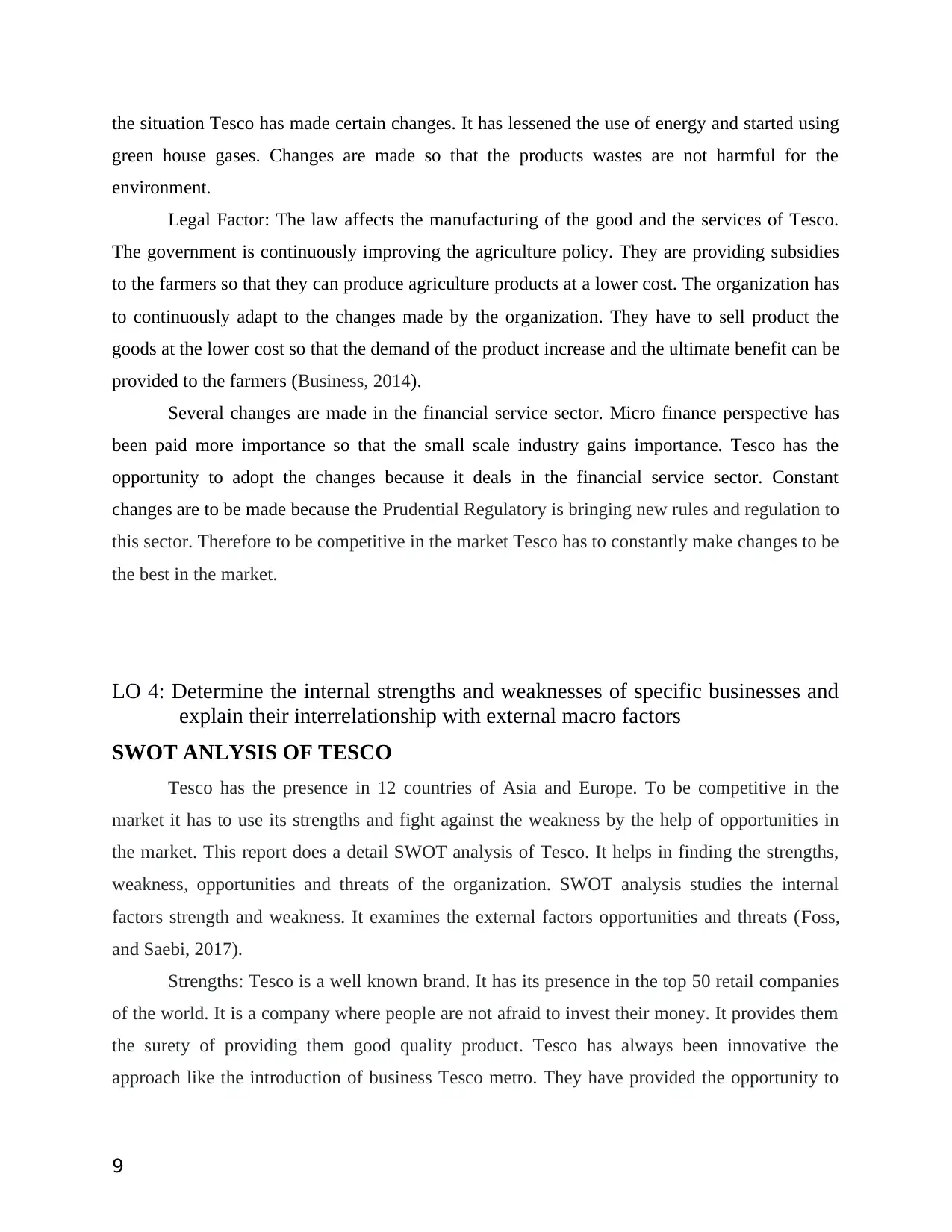
the situation Tesco has made certain changes. It has lessened the use of energy and started using
green house gases. Changes are made so that the products wastes are not harmful for the
environment.
Legal Factor: The law affects the manufacturing of the good and the services of Tesco.
The government is continuously improving the agriculture policy. They are providing subsidies
to the farmers so that they can produce agriculture products at a lower cost. The organization has
to continuously adapt to the changes made by the organization. They have to sell product the
goods at the lower cost so that the demand of the product increase and the ultimate benefit can be
provided to the farmers (Business, 2014).
Several changes are made in the financial service sector. Micro finance perspective has
been paid more importance so that the small scale industry gains importance. Tesco has the
opportunity to adopt the changes because it deals in the financial service sector. Constant
changes are to be made because the Prudential Regulatory is bringing new rules and regulation to
this sector. Therefore to be competitive in the market Tesco has to constantly make changes to be
the best in the market.
LO 4: Determine the internal strengths and weaknesses of specific businesses and
explain their interrelationship with external macro factors
SWOT ANLYSIS OF TESCO
Tesco has the presence in 12 countries of Asia and Europe. To be competitive in the
market it has to use its strengths and fight against the weakness by the help of opportunities in
the market. This report does a detail SWOT analysis of Tesco. It helps in finding the strengths,
weakness, opportunities and threats of the organization. SWOT analysis studies the internal
factors strength and weakness. It examines the external factors opportunities and threats (Foss,
and Saebi, 2017).
Strengths: Tesco is a well known brand. It has its presence in the top 50 retail companies
of the world. It is a company where people are not afraid to invest their money. It provides them
the surety of providing them good quality product. Tesco has always been innovative the
approach like the introduction of business Tesco metro. They have provided the opportunity to
9
green house gases. Changes are made so that the products wastes are not harmful for the
environment.
Legal Factor: The law affects the manufacturing of the good and the services of Tesco.
The government is continuously improving the agriculture policy. They are providing subsidies
to the farmers so that they can produce agriculture products at a lower cost. The organization has
to continuously adapt to the changes made by the organization. They have to sell product the
goods at the lower cost so that the demand of the product increase and the ultimate benefit can be
provided to the farmers (Business, 2014).
Several changes are made in the financial service sector. Micro finance perspective has
been paid more importance so that the small scale industry gains importance. Tesco has the
opportunity to adopt the changes because it deals in the financial service sector. Constant
changes are to be made because the Prudential Regulatory is bringing new rules and regulation to
this sector. Therefore to be competitive in the market Tesco has to constantly make changes to be
the best in the market.
LO 4: Determine the internal strengths and weaknesses of specific businesses and
explain their interrelationship with external macro factors
SWOT ANLYSIS OF TESCO
Tesco has the presence in 12 countries of Asia and Europe. To be competitive in the
market it has to use its strengths and fight against the weakness by the help of opportunities in
the market. This report does a detail SWOT analysis of Tesco. It helps in finding the strengths,
weakness, opportunities and threats of the organization. SWOT analysis studies the internal
factors strength and weakness. It examines the external factors opportunities and threats (Foss,
and Saebi, 2017).
Strengths: Tesco is a well known brand. It has its presence in the top 50 retail companies
of the world. It is a company where people are not afraid to invest their money. It provides them
the surety of providing them good quality product. Tesco has always been innovative the
approach like the introduction of business Tesco metro. They have provided the opportunity to
9
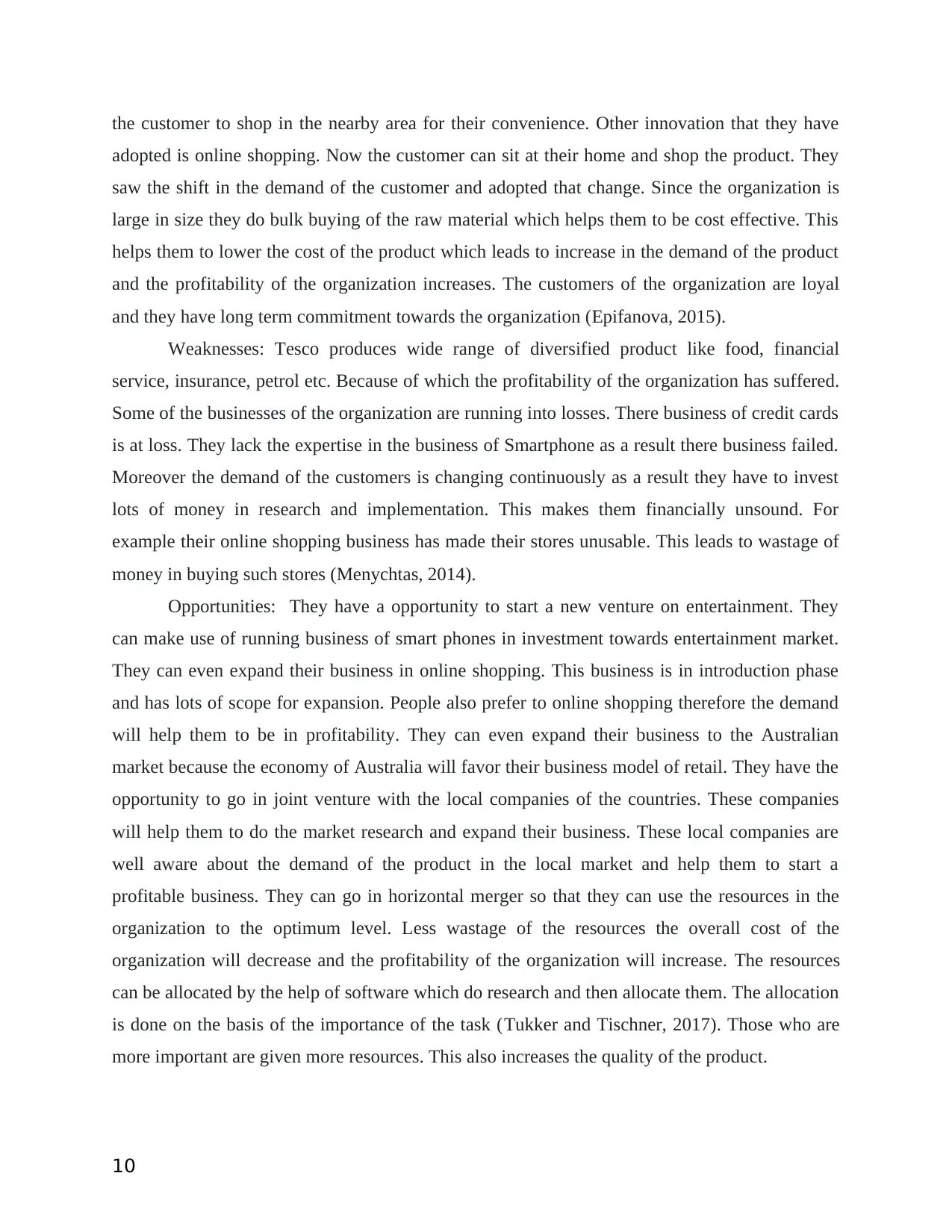
the customer to shop in the nearby area for their convenience. Other innovation that they have
adopted is online shopping. Now the customer can sit at their home and shop the product. They
saw the shift in the demand of the customer and adopted that change. Since the organization is
large in size they do bulk buying of the raw material which helps them to be cost effective. This
helps them to lower the cost of the product which leads to increase in the demand of the product
and the profitability of the organization increases. The customers of the organization are loyal
and they have long term commitment towards the organization (Epifanova, 2015).
Weaknesses: Tesco produces wide range of diversified product like food, financial
service, insurance, petrol etc. Because of which the profitability of the organization has suffered.
Some of the businesses of the organization are running into losses. There business of credit cards
is at loss. They lack the expertise in the business of Smartphone as a result there business failed.
Moreover the demand of the customers is changing continuously as a result they have to invest
lots of money in research and implementation. This makes them financially unsound. For
example their online shopping business has made their stores unusable. This leads to wastage of
money in buying such stores (Menychtas, 2014).
Opportunities: They have a opportunity to start a new venture on entertainment. They
can make use of running business of smart phones in investment towards entertainment market.
They can even expand their business in online shopping. This business is in introduction phase
and has lots of scope for expansion. People also prefer to online shopping therefore the demand
will help them to be in profitability. They can even expand their business to the Australian
market because the economy of Australia will favor their business model of retail. They have the
opportunity to go in joint venture with the local companies of the countries. These companies
will help them to do the market research and expand their business. These local companies are
well aware about the demand of the product in the local market and help them to start a
profitable business. They can go in horizontal merger so that they can use the resources in the
organization to the optimum level. Less wastage of the resources the overall cost of the
organization will decrease and the profitability of the organization will increase. The resources
can be allocated by the help of software which do research and then allocate them. The allocation
is done on the basis of the importance of the task (Tukker and Tischner, 2017). Those who are
more important are given more resources. This also increases the quality of the product.
10
adopted is online shopping. Now the customer can sit at their home and shop the product. They
saw the shift in the demand of the customer and adopted that change. Since the organization is
large in size they do bulk buying of the raw material which helps them to be cost effective. This
helps them to lower the cost of the product which leads to increase in the demand of the product
and the profitability of the organization increases. The customers of the organization are loyal
and they have long term commitment towards the organization (Epifanova, 2015).
Weaknesses: Tesco produces wide range of diversified product like food, financial
service, insurance, petrol etc. Because of which the profitability of the organization has suffered.
Some of the businesses of the organization are running into losses. There business of credit cards
is at loss. They lack the expertise in the business of Smartphone as a result there business failed.
Moreover the demand of the customers is changing continuously as a result they have to invest
lots of money in research and implementation. This makes them financially unsound. For
example their online shopping business has made their stores unusable. This leads to wastage of
money in buying such stores (Menychtas, 2014).
Opportunities: They have a opportunity to start a new venture on entertainment. They
can make use of running business of smart phones in investment towards entertainment market.
They can even expand their business in online shopping. This business is in introduction phase
and has lots of scope for expansion. People also prefer to online shopping therefore the demand
will help them to be in profitability. They can even expand their business to the Australian
market because the economy of Australia will favor their business model of retail. They have the
opportunity to go in joint venture with the local companies of the countries. These companies
will help them to do the market research and expand their business. These local companies are
well aware about the demand of the product in the local market and help them to start a
profitable business. They can go in horizontal merger so that they can use the resources in the
organization to the optimum level. Less wastage of the resources the overall cost of the
organization will decrease and the profitability of the organization will increase. The resources
can be allocated by the help of software which do research and then allocate them. The allocation
is done on the basis of the importance of the task (Tukker and Tischner, 2017). Those who are
more important are given more resources. This also increases the quality of the product.
10
Secure Best Marks with AI Grader
Need help grading? Try our AI Grader for instant feedback on your assignments.
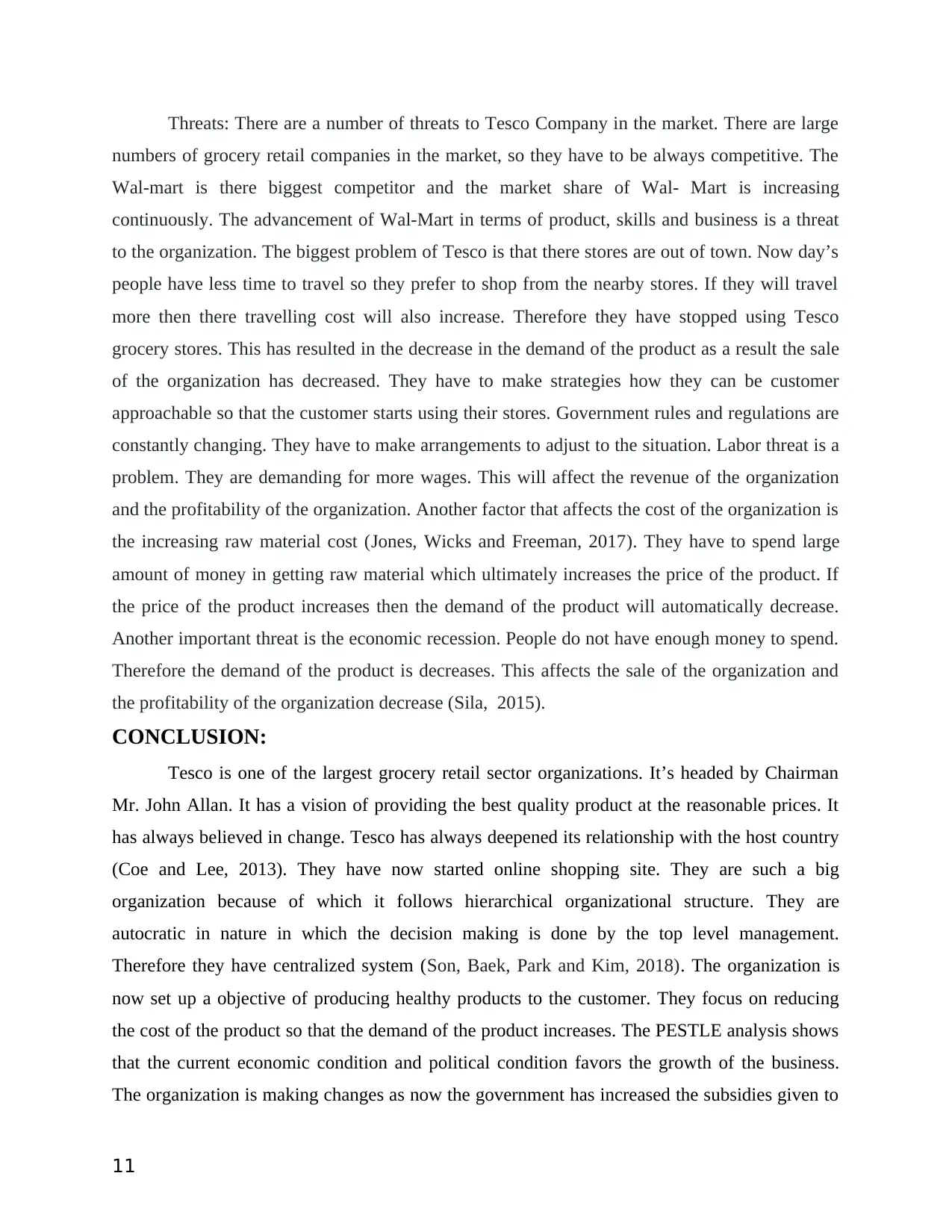
Threats: There are a number of threats to Tesco Company in the market. There are large
numbers of grocery retail companies in the market, so they have to be always competitive. The
Wal-mart is there biggest competitor and the market share of Wal- Mart is increasing
continuously. The advancement of Wal-Mart in terms of product, skills and business is a threat
to the organization. The biggest problem of Tesco is that there stores are out of town. Now day’s
people have less time to travel so they prefer to shop from the nearby stores. If they will travel
more then there travelling cost will also increase. Therefore they have stopped using Tesco
grocery stores. This has resulted in the decrease in the demand of the product as a result the sale
of the organization has decreased. They have to make strategies how they can be customer
approachable so that the customer starts using their stores. Government rules and regulations are
constantly changing. They have to make arrangements to adjust to the situation. Labor threat is a
problem. They are demanding for more wages. This will affect the revenue of the organization
and the profitability of the organization. Another factor that affects the cost of the organization is
the increasing raw material cost (Jones, Wicks and Freeman, 2017). They have to spend large
amount of money in getting raw material which ultimately increases the price of the product. If
the price of the product increases then the demand of the product will automatically decrease.
Another important threat is the economic recession. People do not have enough money to spend.
Therefore the demand of the product is decreases. This affects the sale of the organization and
the profitability of the organization decrease (Sila, 2015).
CONCLUSION:
Tesco is one of the largest grocery retail sector organizations. It’s headed by Chairman
Mr. John Allan. It has a vision of providing the best quality product at the reasonable prices. It
has always believed in change. Tesco has always deepened its relationship with the host country
(Coe and Lee, 2013). They have now started online shopping site. They are such a big
organization because of which it follows hierarchical organizational structure. They are
autocratic in nature in which the decision making is done by the top level management.
Therefore they have centralized system (Son, Baek, Park and Kim, 2018). The organization is
now set up a objective of producing healthy products to the customer. They focus on reducing
the cost of the product so that the demand of the product increases. The PESTLE analysis shows
that the current economic condition and political condition favors the growth of the business.
The organization is making changes as now the government has increased the subsidies given to
11
numbers of grocery retail companies in the market, so they have to be always competitive. The
Wal-mart is there biggest competitor and the market share of Wal- Mart is increasing
continuously. The advancement of Wal-Mart in terms of product, skills and business is a threat
to the organization. The biggest problem of Tesco is that there stores are out of town. Now day’s
people have less time to travel so they prefer to shop from the nearby stores. If they will travel
more then there travelling cost will also increase. Therefore they have stopped using Tesco
grocery stores. This has resulted in the decrease in the demand of the product as a result the sale
of the organization has decreased. They have to make strategies how they can be customer
approachable so that the customer starts using their stores. Government rules and regulations are
constantly changing. They have to make arrangements to adjust to the situation. Labor threat is a
problem. They are demanding for more wages. This will affect the revenue of the organization
and the profitability of the organization. Another factor that affects the cost of the organization is
the increasing raw material cost (Jones, Wicks and Freeman, 2017). They have to spend large
amount of money in getting raw material which ultimately increases the price of the product. If
the price of the product increases then the demand of the product will automatically decrease.
Another important threat is the economic recession. People do not have enough money to spend.
Therefore the demand of the product is decreases. This affects the sale of the organization and
the profitability of the organization decrease (Sila, 2015).
CONCLUSION:
Tesco is one of the largest grocery retail sector organizations. It’s headed by Chairman
Mr. John Allan. It has a vision of providing the best quality product at the reasonable prices. It
has always believed in change. Tesco has always deepened its relationship with the host country
(Coe and Lee, 2013). They have now started online shopping site. They are such a big
organization because of which it follows hierarchical organizational structure. They are
autocratic in nature in which the decision making is done by the top level management.
Therefore they have centralized system (Son, Baek, Park and Kim, 2018). The organization is
now set up a objective of producing healthy products to the customer. They focus on reducing
the cost of the product so that the demand of the product increases. The PESTLE analysis shows
that the current economic condition and political condition favors the growth of the business.
The organization is making changes as now the government has increased the subsidies given to
11
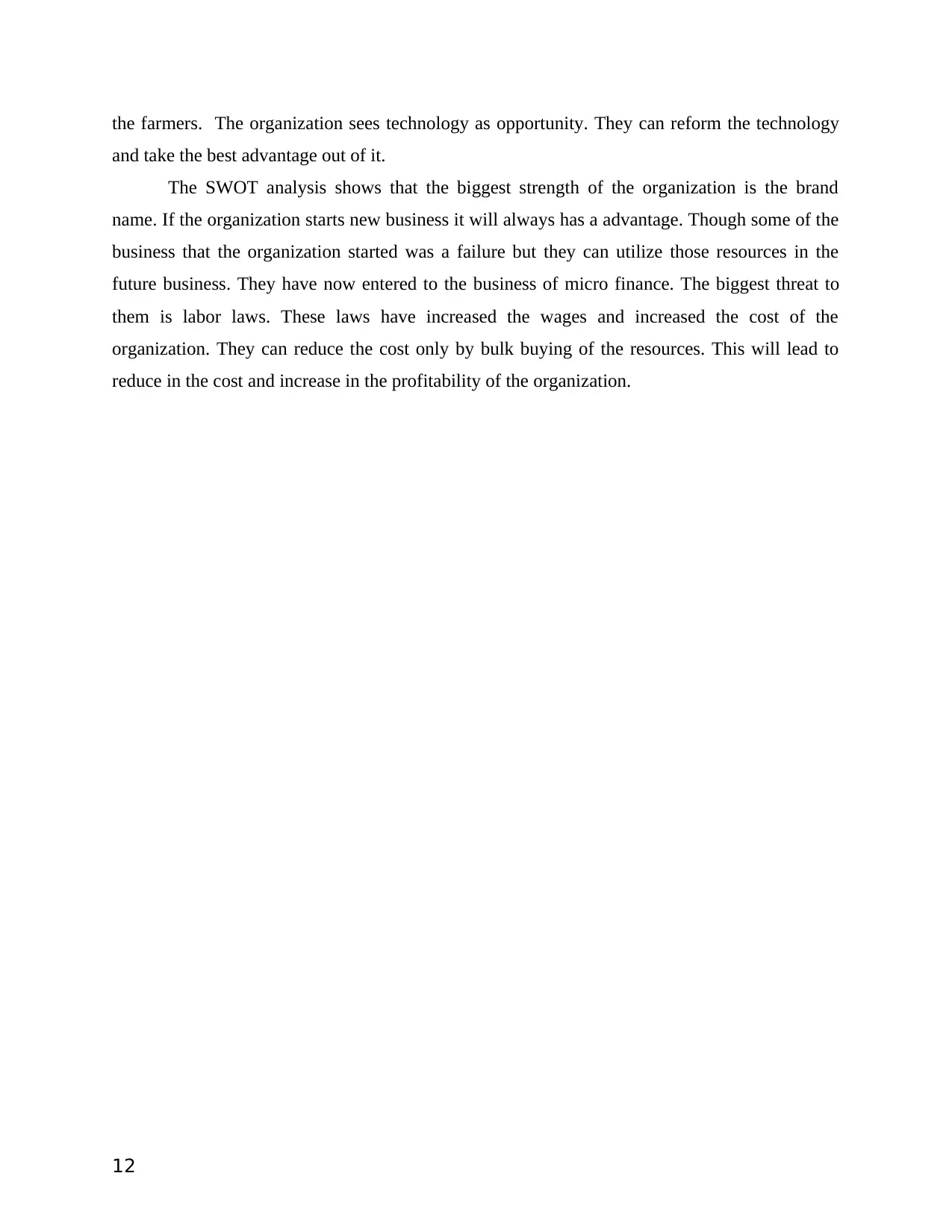
the farmers. The organization sees technology as opportunity. They can reform the technology
and take the best advantage out of it.
The SWOT analysis shows that the biggest strength of the organization is the brand
name. If the organization starts new business it will always has a advantage. Though some of the
business that the organization started was a failure but they can utilize those resources in the
future business. They have now entered to the business of micro finance. The biggest threat to
them is labor laws. These laws have increased the wages and increased the cost of the
organization. They can reduce the cost only by bulk buying of the resources. This will lead to
reduce in the cost and increase in the profitability of the organization.
12
and take the best advantage out of it.
The SWOT analysis shows that the biggest strength of the organization is the brand
name. If the organization starts new business it will always has a advantage. Though some of the
business that the organization started was a failure but they can utilize those resources in the
future business. They have now entered to the business of micro finance. The biggest threat to
them is labor laws. These laws have increased the wages and increased the cost of the
organization. They can reduce the cost only by bulk buying of the resources. This will lead to
reduce in the cost and increase in the profitability of the organization.
12
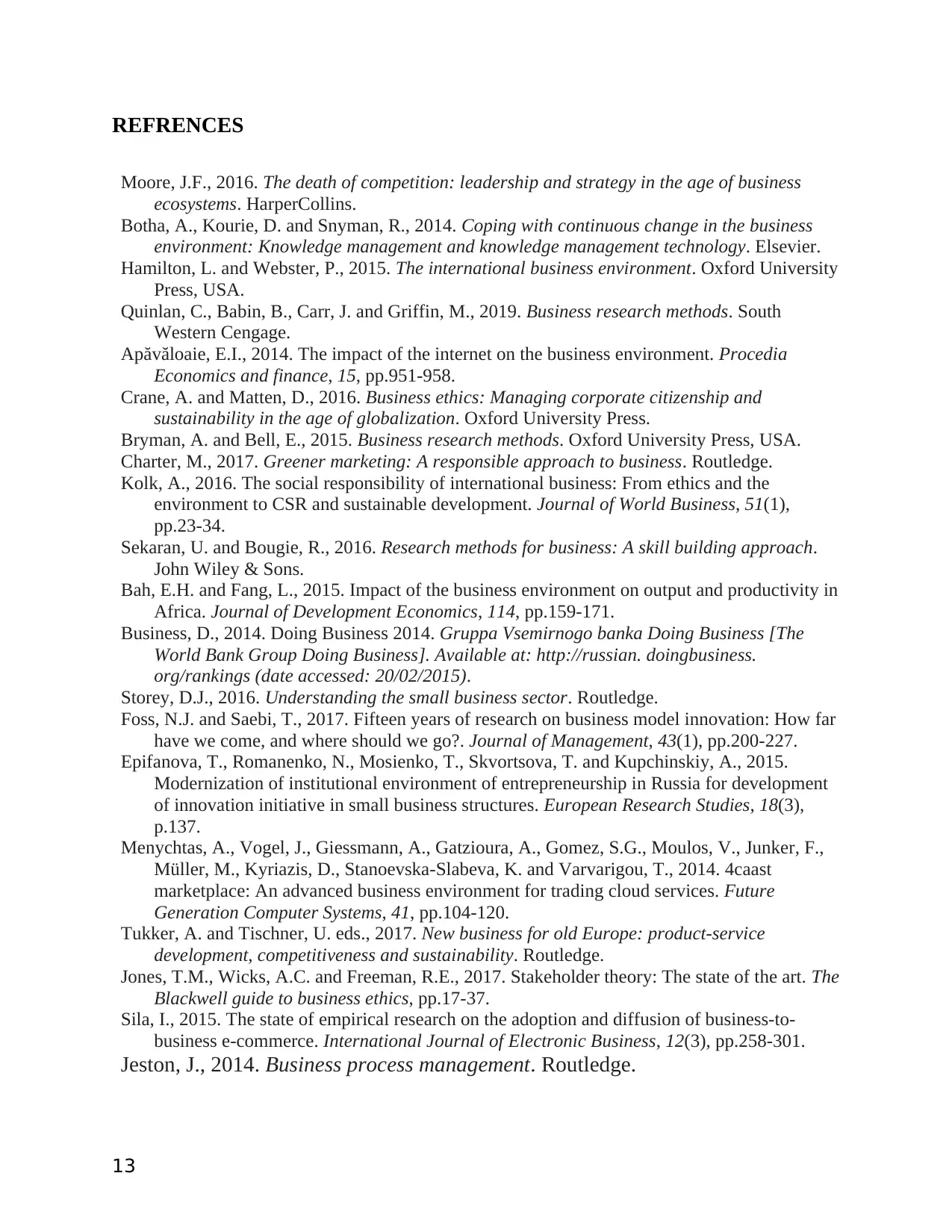
REFRENCES
Moore, J.F., 2016. The death of competition: leadership and strategy in the age of business
ecosystems. HarperCollins.
Botha, A., Kourie, D. and Snyman, R., 2014. Coping with continuous change in the business
environment: Knowledge management and knowledge management technology. Elsevier.
Hamilton, L. and Webster, P., 2015. The international business environment. Oxford University
Press, USA.
Quinlan, C., Babin, B., Carr, J. and Griffin, M., 2019. Business research methods. South
Western Cengage.
Apăvăloaie, E.I., 2014. The impact of the internet on the business environment. Procedia
Economics and finance, 15, pp.951-958.
Crane, A. and Matten, D., 2016. Business ethics: Managing corporate citizenship and
sustainability in the age of globalization. Oxford University Press.
Bryman, A. and Bell, E., 2015. Business research methods. Oxford University Press, USA.
Charter, M., 2017. Greener marketing: A responsible approach to business. Routledge.
Kolk, A., 2016. The social responsibility of international business: From ethics and the
environment to CSR and sustainable development. Journal of World Business, 51(1),
pp.23-34.
Sekaran, U. and Bougie, R., 2016. Research methods for business: A skill building approach.
John Wiley & Sons.
Bah, E.H. and Fang, L., 2015. Impact of the business environment on output and productivity in
Africa. Journal of Development Economics, 114, pp.159-171.
Business, D., 2014. Doing Business 2014. Gruppa Vsemirnogo banka Doing Business [The
World Bank Group Doing Business]. Available at: http://russian. doingbusiness.
org/rankings (date accessed: 20/02/2015).
Storey, D.J., 2016. Understanding the small business sector. Routledge.
Foss, N.J. and Saebi, T., 2017. Fifteen years of research on business model innovation: How far
have we come, and where should we go?. Journal of Management, 43(1), pp.200-227.
Epifanova, T., Romanenko, N., Mosienko, T., Skvortsova, T. and Kupchinskiy, A., 2015.
Modernization of institutional environment of entrepreneurship in Russia for development
of innovation initiative in small business structures. European Research Studies, 18(3),
p.137.
Menychtas, A., Vogel, J., Giessmann, A., Gatzioura, A., Gomez, S.G., Moulos, V., Junker, F.,
Müller, M., Kyriazis, D., Stanoevska-Slabeva, K. and Varvarigou, T., 2014. 4caast
marketplace: An advanced business environment for trading cloud services. Future
Generation Computer Systems, 41, pp.104-120.
Tukker, A. and Tischner, U. eds., 2017. New business for old Europe: product-service
development, competitiveness and sustainability. Routledge.
Jones, T.M., Wicks, A.C. and Freeman, R.E., 2017. Stakeholder theory: The state of the art. The
Blackwell guide to business ethics, pp.17-37.
Sila, I., 2015. The state of empirical research on the adoption and diffusion of business-to-
business e-commerce. International Journal of Electronic Business, 12(3), pp.258-301.
Jeston, J., 2014. Business process management. Routledge.
13
Moore, J.F., 2016. The death of competition: leadership and strategy in the age of business
ecosystems. HarperCollins.
Botha, A., Kourie, D. and Snyman, R., 2014. Coping with continuous change in the business
environment: Knowledge management and knowledge management technology. Elsevier.
Hamilton, L. and Webster, P., 2015. The international business environment. Oxford University
Press, USA.
Quinlan, C., Babin, B., Carr, J. and Griffin, M., 2019. Business research methods. South
Western Cengage.
Apăvăloaie, E.I., 2014. The impact of the internet on the business environment. Procedia
Economics and finance, 15, pp.951-958.
Crane, A. and Matten, D., 2016. Business ethics: Managing corporate citizenship and
sustainability in the age of globalization. Oxford University Press.
Bryman, A. and Bell, E., 2015. Business research methods. Oxford University Press, USA.
Charter, M., 2017. Greener marketing: A responsible approach to business. Routledge.
Kolk, A., 2016. The social responsibility of international business: From ethics and the
environment to CSR and sustainable development. Journal of World Business, 51(1),
pp.23-34.
Sekaran, U. and Bougie, R., 2016. Research methods for business: A skill building approach.
John Wiley & Sons.
Bah, E.H. and Fang, L., 2015. Impact of the business environment on output and productivity in
Africa. Journal of Development Economics, 114, pp.159-171.
Business, D., 2014. Doing Business 2014. Gruppa Vsemirnogo banka Doing Business [The
World Bank Group Doing Business]. Available at: http://russian. doingbusiness.
org/rankings (date accessed: 20/02/2015).
Storey, D.J., 2016. Understanding the small business sector. Routledge.
Foss, N.J. and Saebi, T., 2017. Fifteen years of research on business model innovation: How far
have we come, and where should we go?. Journal of Management, 43(1), pp.200-227.
Epifanova, T., Romanenko, N., Mosienko, T., Skvortsova, T. and Kupchinskiy, A., 2015.
Modernization of institutional environment of entrepreneurship in Russia for development
of innovation initiative in small business structures. European Research Studies, 18(3),
p.137.
Menychtas, A., Vogel, J., Giessmann, A., Gatzioura, A., Gomez, S.G., Moulos, V., Junker, F.,
Müller, M., Kyriazis, D., Stanoevska-Slabeva, K. and Varvarigou, T., 2014. 4caast
marketplace: An advanced business environment for trading cloud services. Future
Generation Computer Systems, 41, pp.104-120.
Tukker, A. and Tischner, U. eds., 2017. New business for old Europe: product-service
development, competitiveness and sustainability. Routledge.
Jones, T.M., Wicks, A.C. and Freeman, R.E., 2017. Stakeholder theory: The state of the art. The
Blackwell guide to business ethics, pp.17-37.
Sila, I., 2015. The state of empirical research on the adoption and diffusion of business-to-
business e-commerce. International Journal of Electronic Business, 12(3), pp.258-301.
Jeston, J., 2014. Business process management. Routledge.
13
Paraphrase This Document
Need a fresh take? Get an instant paraphrase of this document with our AI Paraphraser
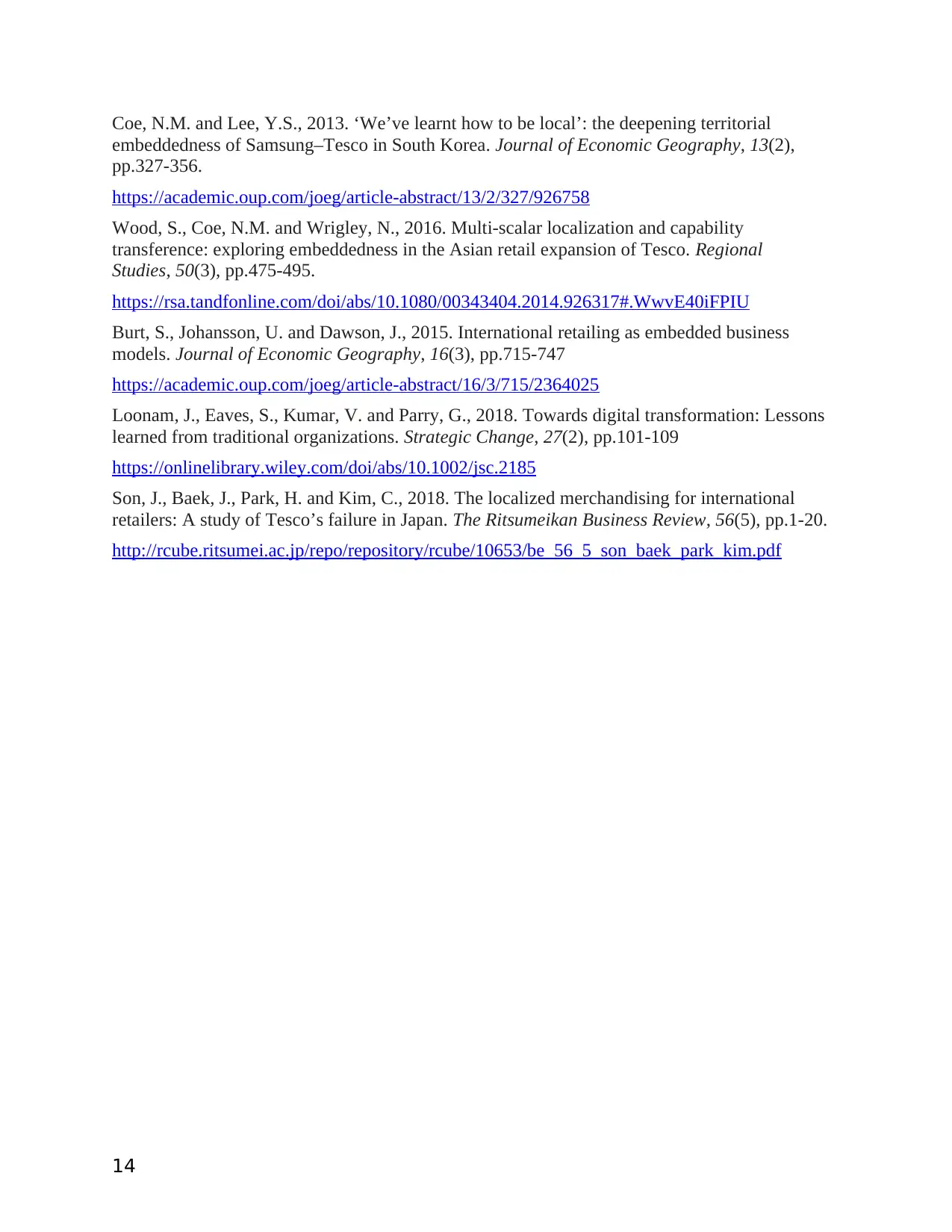
Coe, N.M. and Lee, Y.S., 2013. ‘We’ve learnt how to be local’: the deepening territorial
embeddedness of Samsung–Tesco in South Korea. Journal of Economic Geography, 13(2),
pp.327-356.
https://academic.oup.com/joeg/article-abstract/13/2/327/926758
Wood, S., Coe, N.M. and Wrigley, N., 2016. Multi-scalar localization and capability
transference: exploring embeddedness in the Asian retail expansion of Tesco. Regional
Studies, 50(3), pp.475-495.
https://rsa.tandfonline.com/doi/abs/10.1080/00343404.2014.926317#.WwvE40iFPIU
Burt, S., Johansson, U. and Dawson, J., 2015. International retailing as embedded business
models. Journal of Economic Geography, 16(3), pp.715-747
https://academic.oup.com/joeg/article-abstract/16/3/715/2364025
Loonam, J., Eaves, S., Kumar, V. and Parry, G., 2018. Towards digital transformation: Lessons
learned from traditional organizations. Strategic Change, 27(2), pp.101-109
https://onlinelibrary.wiley.com/doi/abs/10.1002/jsc.2185
Son, J., Baek, J., Park, H. and Kim, C., 2018. The localized merchandising for international
retailers: A study of Tesco’s failure in Japan. The Ritsumeikan Business Review, 56(5), pp.1-20.
http://rcube.ritsumei.ac.jp/repo/repository/rcube/10653/be_56_5_son_baek_park_kim.pdf
14
embeddedness of Samsung–Tesco in South Korea. Journal of Economic Geography, 13(2),
pp.327-356.
https://academic.oup.com/joeg/article-abstract/13/2/327/926758
Wood, S., Coe, N.M. and Wrigley, N., 2016. Multi-scalar localization and capability
transference: exploring embeddedness in the Asian retail expansion of Tesco. Regional
Studies, 50(3), pp.475-495.
https://rsa.tandfonline.com/doi/abs/10.1080/00343404.2014.926317#.WwvE40iFPIU
Burt, S., Johansson, U. and Dawson, J., 2015. International retailing as embedded business
models. Journal of Economic Geography, 16(3), pp.715-747
https://academic.oup.com/joeg/article-abstract/16/3/715/2364025
Loonam, J., Eaves, S., Kumar, V. and Parry, G., 2018. Towards digital transformation: Lessons
learned from traditional organizations. Strategic Change, 27(2), pp.101-109
https://onlinelibrary.wiley.com/doi/abs/10.1002/jsc.2185
Son, J., Baek, J., Park, H. and Kim, C., 2018. The localized merchandising for international
retailers: A study of Tesco’s failure in Japan. The Ritsumeikan Business Review, 56(5), pp.1-20.
http://rcube.ritsumei.ac.jp/repo/repository/rcube/10653/be_56_5_son_baek_park_kim.pdf
14
1 out of 14
Related Documents
Your All-in-One AI-Powered Toolkit for Academic Success.
+13062052269
info@desklib.com
Available 24*7 on WhatsApp / Email
![[object Object]](/_next/static/media/star-bottom.7253800d.svg)
Unlock your academic potential
© 2024 | Zucol Services PVT LTD | All rights reserved.




![[SOLVED] Understanding Business Structures and Market Equilibrium](/_next/image/?url=https%3A%2F%2Fdesklib.com%2Fmedia%2Fimages%2Fhc%2F43915555878b440a9e14b7790def5638.jpg&w=256&q=75)